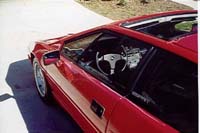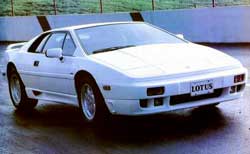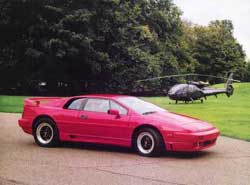

Lotus Esprit Turbo
EVERYDAY EGO BOOST (US)
AS AN EGO car, the current iteration of the Lotus Esprit Turbo succeeds. A Ferrari of any sort or a slant-nose 911 might work better because of its greater name recognition amongst the masses, but not that you'd notice the difference. Cruise down a main boulevard in the Esprit and people will stare. At gas stations, attendants will ask in-numerable questions. Or one will step to the fore and deliver a lecture on the technical merits of the engine and chassis, with a brief aside on active suspension and Formula One victories. And in the valet parking of nightclubs, the Esprit will turn the head of every woman waiting in line, and incur the envy of every guy. This car, like others of its breed, will inflate its master's ego to huge dimensions. Settling into any other production car is a crushing blow.
Which is fine if a bit of psychotherapy is all that's needed. But how does an ego car of such extreme design measure up if, in a week's time, nearly 2000 miles are added to its odometer reading? A man can love this car but can he live with it? Is it a car a sane man would drive cross-country, or 500 miles for a rendezvous with a young woman? Is it a reasonable alternative to a small plane?
Certain compromises are made before even entering the ear. The doors don't open too wide because of the tight placement of the hinges. This poses no problem for the limber and athletic, but attempts to enter or exit the car on the part of old folks and women in tight skirts are utterly devoid of grace. The only smooth entry form is to aim your bum at the pocket of the seat, push back with your heels, duck your head, and then draw in the legs over the wide sill like a yoga instructor preparing you for- you guessed it-the lotus position. Once inside, the going isn't so tough. The seats move forward and back, but they are so perfectly sculpted no further adjustments are needed. To better fit the car to taller North Americans, a set of washers and aluminum blocks can be removed from under the seat track dropping it by two inches. This not only keeps stray hairs from catching on the spongy headliner, but makes it possible to see the tops of the speedometer and tach clearly through the chunky steering wheel. Without these height adjustments the car would be miserable to anyone standing more than five foot eight.
The cars second test in practicality was a trip to the grocery store. The rear stowage area, right behind the engine, can easily hold a weeks worth of groceries for a bachelor: two six packs of cold ones, a few bags of health-consciously prepared junk food, and a carton of eggs for Sunday brunch omelettes. This rear shelf slopes at the rear and if the bags are carefully nestled between the battery and an old leather jacket or sweater, they won't bounce all over. There is no need to toss the bags in the passenger seat.
Dodging past shopping carts in the parking lot brings some criticism for the heavy low-speed steering. Parallel parking isn't easy on the forearms, either, but with the switch from the old Citroen-Maserati transaxle to the Euro-model's Renault box, popping into reverse isn't the arm wrestling match it was only a year ago. Once the Esprit is jumping from stoplight to stoplight, it is little more difficult to guide than our long-term Supercharged MR2. Around town, the suspension is taut but comfortable. Every ripple is felt through the wheel and seat, but the ride is not jarring. Changing lanes is not difficult, the combination of adequate rear vision, huge mirrors, and tremendous acceleration making the act a simple one. Vision out of the car isn't much worse than from the driver's seat of a small sedan. Ego cars are embarrassing if they cannot answer the challenge of lesser modes of transportation. Such a challenge came our way on Balboa Boulevard on a Saturday afternoon when a Saleen Mustang sitting in the next lane suddenly launched from the stop sign, full throttle. In spite of a nearly two-car lead off the line, the Mustang was reeled in by the time fourth gear was just beginning.
Which isn’t surprising because the '89 Esprit, which now packs 228 horsepower in its little twin cam turbo four, can run from 0 to 60 in 4.8 seconds and hit 100 in 11.4! When the car was delivered we met the man who originally racked up those impressive numbers, a short, quiet guy named Alistair who trains all the test drivers at the factory in Hethel. He had come to Newport Beach to instruct the guys at another big-time car magazine in the fine art of shifting the Lotus from first to second to achieve the sub-5 second 0-60 time.
when the car was aimed for Bodega Bay, north of San Francisco. Once out of L.A. on a Sunday morning, the pace picked up to a steady 95 to 100 mph and was maintained for around two hours. The lack of a dead pedal led to some discomfort because the left foot must either lay under the clutch pedal or rest on the wide door jam, pushing the knee up high. Still, at the end of that two hour run through the tabletop flatness of the San Joaquin Valley, which included many fourth and fifth gear roll-ons to indicated speeds as high as 150mph, I was not fatigued in the least by the car. Only by the sight of police radar planes above the highway.
After a stretch of the legs in a truck stop, there were a few hours left to the trip. While still in the flat plain of the San Joaquin, the car was rolled up to an indicated 150 several times; on one occasion where there was enough clear road, the speedo was pushed to nearly 158. At that speed the engine takes on a husky, serious tone, and you know it is not just loafing like it does at 100; at 150 the engine feels like the heart of a runner doing sprints up stadium stairs. The car tracks perfectly straight and is not inclined to follow camber nor cracks or ripples in the pavement. Taking hands from the wheel isn't advised, but it can be done for a brief second. It is at speeds like this that the true purpose of the chassis comes through. Speeds upwards of 130 — where common cars are beginning to run out of breath and grow skitterish — are the province of this car.


When the Peterbilt tractor trailers hauling potatoes or peppers or hogs became more than specks on the horizon, it was time to test the big callipers. Having no choice but to drop from 150+ to 70 mph in a matter of a few seconds is an eerie feeling. You can only press evenly on the brake pedal and watch through the windshield shield, waiting for the brakes to finish their work and for the speedo to drop. The car surpassed 150mph at least a dozen times, and the brakes never complained or gave cause for alarm. The brake pedal was always firm and progressive. Never was there fear that the fibreglass bodywork would become violently attached to the back of a farm truck.
I arrived in Marin County just north of the Golden Gate Bridge, a few hours later a total journey of more than 470 miles that ended with a 30 minute drive through heavy downtown traffic. By that time I felt the nervous nature of the chassis and the buzzing of the little four cylinder throughout my body, and my backside was numb because either the seat or my body needs an extra inch of padding. The car's primary contribution to my fatigue was noise: tire noise from the big Gatorbacks at high speed; noise from the ventilation fan, which must spin quickly to push sufficient air into the cabin; and noise from the four cylinder engine, which doesn't have the refined nature of a Rolls V8. The Esprit may be a bit too frantic and high-strung to function as a comfortable grand touring car for anyone over the age of 30 who isn't physically fit, but it had covered many hundreds of miles in short order.
The first night in San Francisco was spent touring rain-swept streets with a pouty female warming the Connolly hides of the passenger's seat. On the steeply climbing streets of the city, the Gatorbacks were neither happy nor helpful. The rear wheels would spin when taking off with more than quarter throttle, and the car was inclined to slipping and sliding around 90 degree street comers if the speed was much more than a cruise; the full capabilities of the suspension can only be exploited in the dry. The big single wiper tends to bounce and skip over the windshield unless there is plenty of rainwater. And the clear plastic panel that connects the flying buttresses at the rear collects water pellets and rivulets that obscure sight through the top half of the rear-view mirror; but the lower half of the mirror — a sliver of less than an inch — is kept clear of raindrops. And one old problem created by the two rear windows and the clear sail panel remains. At night the green light of the gauges is reflected on all three glass panels, which can interfere with rearward vision.
The following day several hundred more miles were added to the odometer, all of them on narrow roads clinging to cliffs just over the ocean or through rolling farm valleys that spear the coastline. If the Lotus is not the happiest grand touring car, it does rate among the best sprinters I've ever driven. The coastal road overhanging Bodega Bay has both tight and sweeping bowl turns, lots of extreme elevation changes, and blind curves of more than 180 degrees. In the faster sweeping turns the car is perfectly settled, never placing a wheel out of line and never assuming a posture that requires correction by either steering or throttle. In tighter turns, especially bowls placed in dips at the end of fast straights, the front end slides out if the throttle is held steady. The most effective way to take such turns is to carry in a touch too much speed, jump off and back on the throttle, and let the rear end do most of the steering. Problem is, until a week's time has been spent slashing up and down roads like this, it's hard to make the rear end trace a steady arc. The steering is so fast and accurate that a slight twitch brings the tail right back home before the car is entirely out of the turn. The car is fast through these turns, but it can look a bit jerky. With practice, a driver could likely smooth things out.
Any comer, fast or slow, tight or sweeping, only heightens
appreciation of the steering. Lotus steering seems a bit heavy at times, but
it is unparalleled in accuracy and quickness. No Porsche or Ferrari can match
it. End of sentence.
The bright, clear light of dawn brought up another problem. The windshield,
which is an almost completely flat pane of glass, slants at a steep angle,
giving the car that erotic silhouette. But if you pop out of a shadow into
the light of a low-hanging sun, the entire windshield turns into white glare,
which can complicate the matter of cornering. Nothing can be seen and you'll
find yourself ducking down low in hopes of seeing the road again. In a car
capable of eating up tarmac so quickly, this can be a heart-stopping event.
The day ended on the one road running through Mt. Tamalpais State Park; the road feels much like the country highways of northern England or Wales. The final photos of the day were taken along the shoulder. It's at those times you notice elements of the Esprit a photographer's lens cannot capture. Press the button or the headlights and they flip up or down with a decisive thump that sounds just right. Flash the high beams and the stalk clicks with hard precision. The clear sail panel in the back catches heat rising from the engine just below it and rolling, migrating streaks develop on its underside. Climb down the cliff, place your eyes at road level, and the wide stance of the car seems overwhelming. No, not like a Testarossa, but broad and strong nonetheless. And when the sun is gone and the rear lid is finally closed on a few thousand dollars worth of cameras, the two latches snap shut with a sound like the cracking knuckles of a Chicago mobster.
With the day's work done, the sprint back to the city was a joy. The asphalt on Mt. Tamalpais drops well over a thousand feet through a forest of coastal pines. Many hours of hard driving had given the confidence to turn up the wick and drive so fast that there were no straights, only entrances and exits to turns. Slower cars were passed on the inside of corkscrew turns and the revs never dropped below 5000. For the ten minutes spent racing back to the main highway, the car felt perfectly suited to the task, maybe because the road was so English in nature. The Lotus may not have the smoothest engine in the world, but its suspension cannot be faulted.
At the start we asked if a man could live with the Lotus Esprit Turbo everyday. With its lack of grand touring ability put aside, the answer is yes, positively. It is comfortable in a cosy fashion, reliable so far as we could see, quiet within reason, and takes on city traffic with the skill of a Federal Express delivery van. The pedals are heavy, but a week of driving makes them feel just right. It can carry groceries or a few travel bags for two. The ride is taut, but it won't beat a guy's kidneys to pulp just tooling around town. And if the steering is a bit heavy, well, it will also strengthen your double-fisted backhand grip on a tennis racquet.
If Lotus products continue to improve over the next few years and perform as well or better as this car, and possibly if they develop a newer, larger engine, the company's cars could battle with Porsche Turbos for the title of best everyday exotic.

|
|